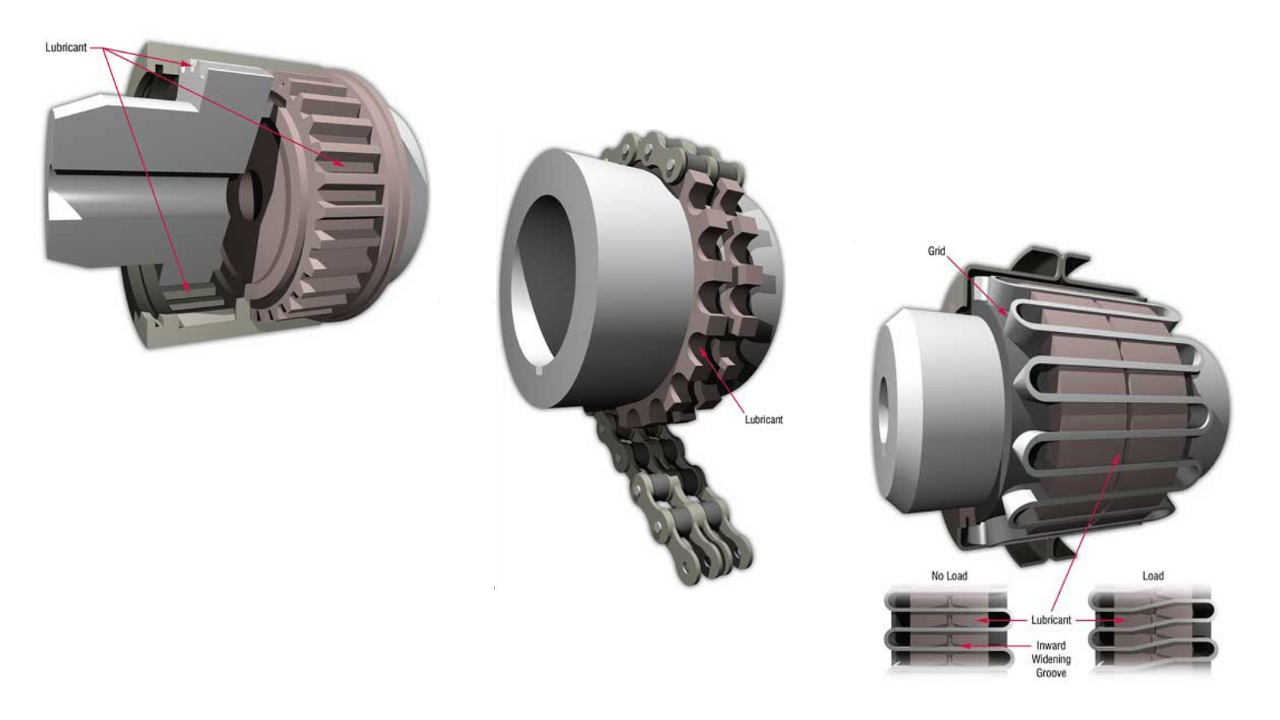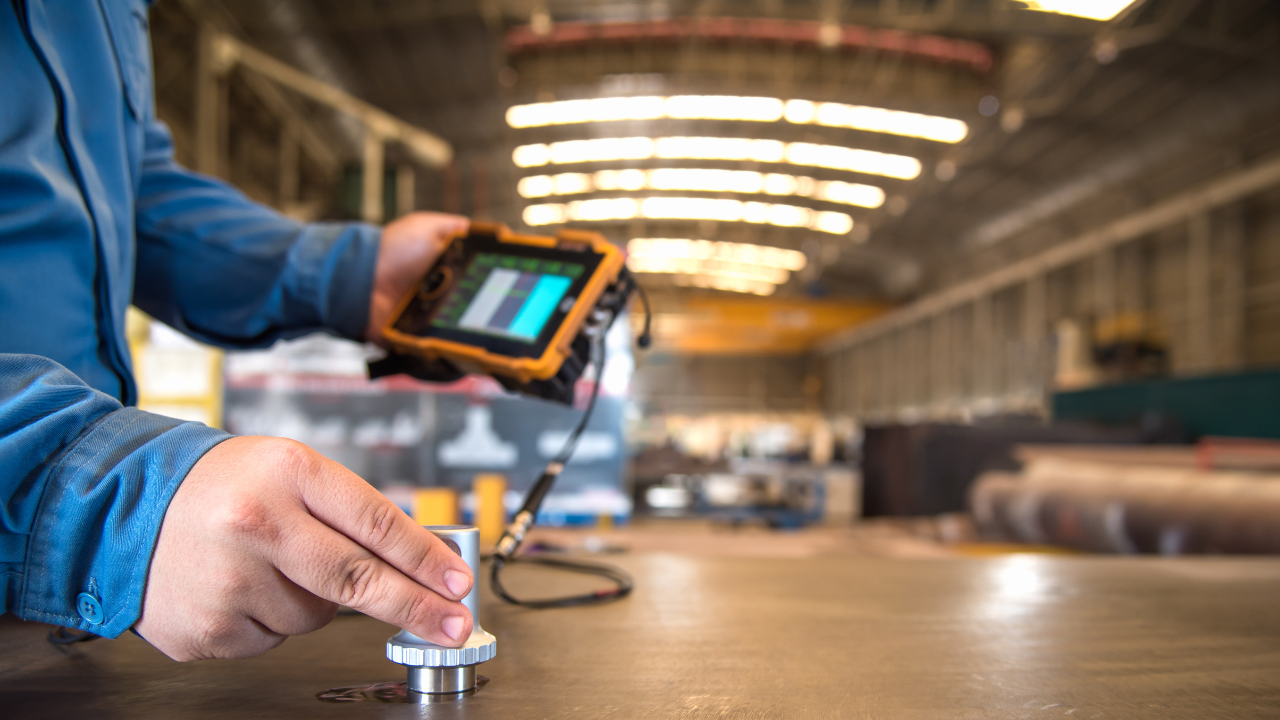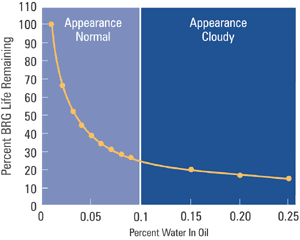Water: The Forgotten Contaminant
Mark Barnes, Noria Corporation
Much has been said about particle contamination and its effect on component longevity. It is well known that an improvement in particle contamination by one ISO Cleanliness Code can result in a 10 to 30 percent increase in the life of contamination-sensitive components such as hydraulic valves, pumps, and journal and rolling element bearings. Industry spends millions of dollars each year on improved filtration technology in an attempt to reduce particle contamination, with some of the more advanced companies reducing failure rates by up to 90 percent simply by controlling fluid cleanliness. However, in some industries and environments, water is a far more insidious contaminant than solid particles. Water contamination is often overlooked as the primary cause of component failure.
States of Coexistence
Water can exist in oil in three states or phases.
1. The first state, known as dissolved water, is characterized by individual water molecules dispersed throughout the oil. Dissolved water in a lubricating oil is comparable to moisture in the air on a humid day – we know the water is there, but because it is dispersed molecule-by-molecule, it is too small to see. For this reason, an oil can contain a significant concentration of dissolved water with no visible indication of its presence. Most industrial oils such as hydraulic fluids, turbine oils, etc., can hold as much as 200 to 600 ppm of water (0.02 to 0.06 percent) in the dissolved state depending on the temperature and age of the oil, with aged oils capable of holding three to four times more water in the dissolved state than new oil.
2. Once the amount of water has exceeded the maximum level for it to remain dissolved, the oil is saturated. At this point, the water is suspended in the oil in microscopic droplets known as an emulsion. This is similar to the formation of fog on a cool, spring day. In this case, the amount of moisture in the air exceeds the saturation point, resulting in a suspension of small droplets of moisture or fog. In a lubricating oil, this “fog” is often referred to as haze with the oil said to be cloudy or hazy.
3. The addition of more water to an emulsified oil/water mixture will lead to a separation of the two phases producing a layer of free water as well as free and/or emulsified oil. This is like rain falling when the amount of moisture in the air becomes excessive. For mineral oils and PAO synthetics whose specific gravity is less than 1.0, this free water layer is found on the bottom of tanks and sumps.
The Effects of Water Contamination
In a lubricating system, the two most harmful phases are free and emulsified water. In journal bearings for example, the incompressibility of water relative to oil can result in a loss of the hydrodynamic oil film that in turn leads to excessive wear. As little as one percent water in oil can reduce the life expectancy of a journal bearing by as much as 90 percent. For rolling element bearings, the situation is even worse. Not only will water destroy the oil film strength, but both free and emulsified water under the extreme temperatures and pressures generated in the load zone of a rolling element bearing can result in instantaneous flash-vaporization causing erosive wear to occur.
Under certain conditions, water molecules can be ripped up into their constituent oxygen and hydrogen atoms as a result of the high pressures generated in the load zone of a rolling element bearing. Due to their relatively small size, the hydrogen ions produced by this process can absorb onto the surface of the bearing raceway resulting in a phenomenon known as hydrogen embrittlement. Hydrogen embrittlement is caused by a change in subsurface bearing metallurgy. This change causes the bearing material to become weak or brittle and prone to cracking beneath the surface of the raceway. When these subsurface cracks spread to the surface, the result can lead to pitting and spalls.
Because the effects of free and emulsified water are more harmful compared to dissolved water, a general rule of thumb is to ensure that moisture levels remain well below the saturation point. For most in-service oils this means 100 to 300 ppm or less depending on the oil type and temperature. However, even at these levels, a significant amount of damage from water contamination can still occur. Generally speaking, there is no such thing as too little water and every reasonable effort should be made to keep water contamination as low as possible.
The Effects of Water on a Lubricant
Not only does water contamination have a direct harmful affect on machine components, but it also plays a direct role in the aging rate of lubricating oils. The presence of water in a lubricating oil can cause the progress of oxidation to increase tenfold, resulting in premature aging of the oil, particularly in the presence of catalytic metals such as copper, lead and tin. In addition, certain types of synthetic oils such as phosphate esters and dibasic esters are known to react with water, resulting in the destruction of the base stock and the formation of acids.
It is not just the base oil that can be affected by moisture contamination. Certain additives such as sulfurous AW and EP type additives and phenolic antioxidants are readily hydrolyzed by water, resulting in both additive mortality and the formation of acidic by-products. These acidic by-products can then cause corrosive wear, particularly in components containing soft metals such as Babbitt used with journal bearings and bronze and brass components. Other additives such as demulsifying agents, dispersants, detergents and rust inhibitors can be washed away by excessive moisture. This results in sludge and sediment buildup, filter plugging and poor oil/water demulsibility.
Measuring Water
In order to control moisture levels, one must be able to detect its presence. There are five basic test methods used to determine the moisture content of a lubricating oil. These methods range from a simple apparatus to a more complex chemical test or slightly more expensive percent saturation probe test ideal for on-site screening purposes. It may also include more advanced technology typically used in laboratories for precise determination of the water level in ppm.
The most basic is the Crackle Test. In this test, a hot plate is held at 320°F (130°C) and a small drop of oil placed in the center. Any moisture present in the oil is reflected in the number of bubbles observed as the water vaporizes. Depending on the lubricant, relatively few small bubbles indicate approximately 500 to 1,000 ppm (0.05 to 0.1 percent) water. Significantly more bubbles of a larger size may indicate around 1,000 to 2,000 ppm water, while an audible crackling sound indicates moisture levels in excess of 2,000 ppm. The Crackle Test is sensitive only to free and emulsified water.
Another simple on-site test is the use of a pressure cell where the sample is prepared with a chemical reagent (calcium hydride) and placed in a container and shaken vigorously. A change of pressure within the cell is monitored to determine if free water is present. The cost of this type of product is relatively low, although the running costs must be considered with regard to the reagents, as well as the health and safety issues of these reagents. Suppliers include Kittiwake, Koehler and Dexsil.
A third type of on-site screening test for water is the use of a relative humidity sensor. The sensor uses a thin film capacitance grid that can determine the amount of moisture permeating through the film. Whether used in air or oil, the technology is the same and the output of data is normally in a percent RH value. As discussed earlier, the percent RH is an indication of whether the oil has yet reached the saturation point, although as in the atmosphere, the lower the temperature, the lower the saturation point in terms of water concentration. While it is mathematically possible to derive a ppm value from the percent RH against the saturation curve for the oil at a known temperature, the thinking behind this type of sensor is to provide a proactive early warning of imminent problems as well as providing a screening capability prior to sending a sample to a commercial laboratory. The water saturation article on page 82 gives a clear description of the performance and applicability of this tool. The advantage of this method is its relatively low running costs and that it can be permanently mounted on critical plant equipment to provide real-time monitoring. Suppliers include Pall Corporation and Rockwell Automation – Entek.
Aside from the on-site screening methods, another commonly used method to screen for water is Fourier Transform Infrared Spectroscopy (FTIR). This test is sensitive to free, emulsified and dissolved water, however it is limited in precision to a lower detection limit of about 1,000 ppm. This is adequate for some applications, but insufficient for typical industrial applications. Commercial laboratories that use this method often report that less than 0.1 percent volume of water is present in the sample. Suppliers include Bio-Rad, MIDAC, Nicolet and Thermolube.
The most precise method for determining the amount of free, emulsified and dissolved water in a lubricating oil is the Karl Fischer moisture test. When used correctly, the Karl Fischer test is capable of quantifying water levels as low as 10 ppm or 0.001 percent and should be the method of choice when more exact water concentrations need to be known. Care should be exercised when using the Karl Fischer moisture test to avoid interference effects caused by sulfurous EP and AW additives. Suppliers include Mettler and Metrohm.
Whichever method is used to determine water levels, one thing is certain: Water contamination is a major cause of lubricant failure, component failure and poor machine reliability. Like all contaminants, it is important not only to recognize the presence of water contamination, but also to take steps to control or eliminate the source of water ingression. If possible, water levels in all equipment should be kept below the saturation limit, with every effort made to keep moisture levels as low as possible. Whether you choose to install desiccant style breathers, improve seals, or to use a centrifugal filter or a large vacuum dehydration unit, reducing the level of water in all types of equipment can dramatically extend the life of the lubricant and the machine.
Related Articles

The Lubrication Requirements of Couplings

The Building Blocks to Creating an Effective Lubrication Program

Does Lubrication Belong in the CMMS?

Ultrasound for Better Lubrication

Top Ten Ways Not to be World Class at Machinery Lubrication






